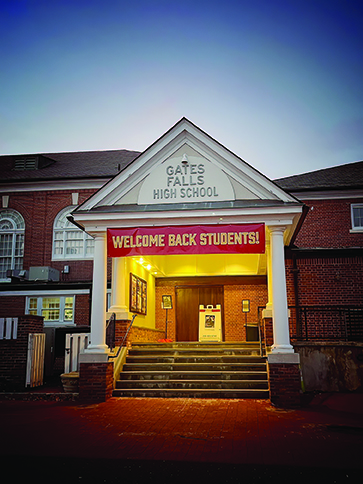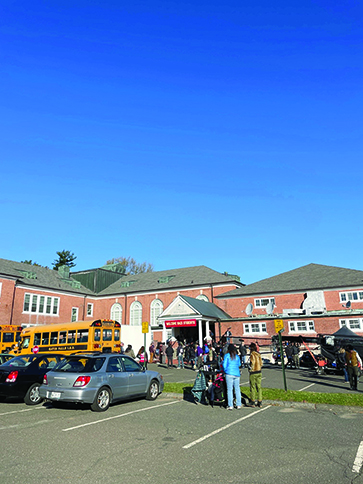“The overall look and feel should be timeless, classic, small town Maine. The color palette is autumnal, wintery and unmistakably New England.”
Those were the official production notes for Mr. Harrigan’s Phone, a 2021 feature film shot in Connecticut, streaming on Netflix. Based on Stephen King’s short story of the same name and adapted for the screen by the film’s director, John Lee Hancock, the movie stars celebrated actor Donald Sutherland as John Harrigan, a misanthropic billionaire; and up-and-comer Jaeden Martel as Craig, a boy who develops an unlikely and enduring friendship with the reclusive Mr. Harrigan. Bizarrely their connection doesn’t end with the elderly man’s death but takes on a more sinister, supernatural complexity.
 As with all Stephen King stories, the fictional town of Harlow, Maine feels strangely familiar. It’s as if you stopped in there for gas but suddenly become inexplicably anxious to leave. You can’t quite put your finger on what’s off about the place, but an innately malevolent element is clearly at play.
As with all Stephen King stories, the fictional town of Harlow, Maine feels strangely familiar. It’s as if you stopped in there for gas but suddenly become inexplicably anxious to leave. You can’t quite put your finger on what’s off about the place, but an innately malevolent element is clearly at play.
In Mr. Harrigan’s Phone the opening and closing sequences were shot at a craggy lake quarry in Portland, Maine, but the rest of the film was variously lensed in Norwalk, Westport, Stamford, Wilton, Ridgefield, Greenwich, Fairfield and Barkhamsted, Connecticut.
Norwalk’s Lockwood-Matthews Mansion Museum has a starring role as Mr. Harrington’s forbidding Victorian home. A convenience store on Route 7 plays the small but critical part of Howie’s Market, where devilish lottery tickets are sold. If you look carefully, many other familiar Fairfield County landmarks can be spotted.
 According to Damon Gordon, the film’s location scout, there was an exhaustive search for a high school exterior. “Then we came upon the Ridgefield Playhouse. At first, we were interested in the front facade of the building with the long drive up. But then our scout team came upon the rear, which is the main entrance for the Playhouse, and we were sold. With some minor set dressing, and lots of liaising with the many entities that share the parking lot, we were able to create our fictitious Gates High School,” says Gordon.
According to Damon Gordon, the film’s location scout, there was an exhaustive search for a high school exterior. “Then we came upon the Ridgefield Playhouse. At first, we were interested in the front facade of the building with the long drive up. But then our scout team came upon the rear, which is the main entrance for the Playhouse, and we were sold. With some minor set dressing, and lots of liaising with the many entities that share the parking lot, we were able to create our fictitious Gates High School,” says Gordon.
In the story, Craig attends high school as a freshman and is confronted by a disturbed, physically threatening bully. Though the high school scenes are often dark, the mood on set was anything but, according to Playhouse Executive Director Jared Shahid.
“The community was excited for the production to set up at the Playhouse,” says Shahid. “It was fun for everyone to see the crew popping up at different locations. There was a genuine buzz around town.”
Six critical exterior shots needed to be captured at the Playhouse. They were scheduled for two possible days in October but a snow storm hit, creating a logistical nightmare. Filming was frantically rearranged for November 9, the only day available—and the production had to adhere to strict wrap time to allow the Pat Methany band to load in for their performance that night.
“There were 60 crew and 75 cast members, five working tractor trailers, seven campers, four food service vehicles, approximately 50 personal crew vehicles, four stake beds and eight 15-person passenger vans,” says Shahid. High school interiors were shot at Norwalk Community College but viewers will be completely fooled when watching the film because the two disparate locations match so perfectly.
There’s been a huge uptick in production in the Nutmeg State over the past few years including major productions for HBO, Hallmark, Netflix and Amazon. George Norfleet, Director of the Connecticut Office of Film, TV & Digital Media explains why. “Connecticut offers a wide, rich variety of distinctive location choices that range from bucolic rolling countryside to modern cityscape to magnificent coastline. That coupled with excellent film crews and a competitive tax incentive to help budgets go further, makes Connecticut a winning choice.”
 Local actors and crew are happy for the regular work. Rachel Konstantin, a Norwalk-based actress, who has worked as a background performer on many films, including Mr. Harrigan’s Phone, loves the experience of staying in Connecticut. “The locals are thrilled to have a Hollywood movie filming in their own backyard,” she says. “Kids and their parents come out to watch and take pictures and there’s a wonderful feeling of excitement.”
Local actors and crew are happy for the regular work. Rachel Konstantin, a Norwalk-based actress, who has worked as a background performer on many films, including Mr. Harrigan’s Phone, loves the experience of staying in Connecticut. “The locals are thrilled to have a Hollywood movie filming in their own backyard,” she says. “Kids and their parents come out to watch and take pictures and there’s a wonderful feeling of excitement.”
It’s not just about good vibes though. Making films is a business and having a production choose your neighborhood can be a huge financial plus. A cast and crew of 100 to 200 people filming for a day, a week, a month or even longer, translates into real dollars that flow directly back to the community. People stay at nearby hotels, shop, eat and drink at local restaurants and bars, and generally spread the monetary love.
When asked if the Playhouse would consider starring in another production, Shahid says, “Absolutely. It takes a lot of time and logistical coordination, but ultimately, it’s a win for all of us. How fun is it to watch a movie and see your town in it?” •